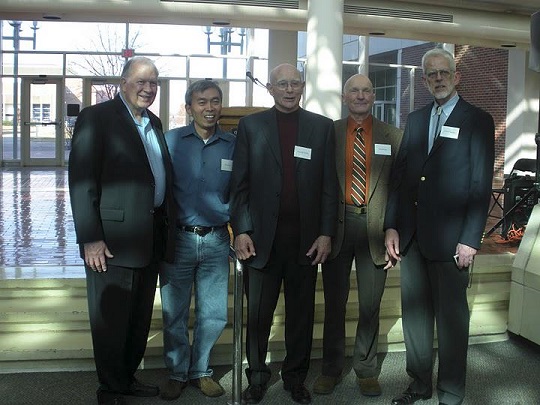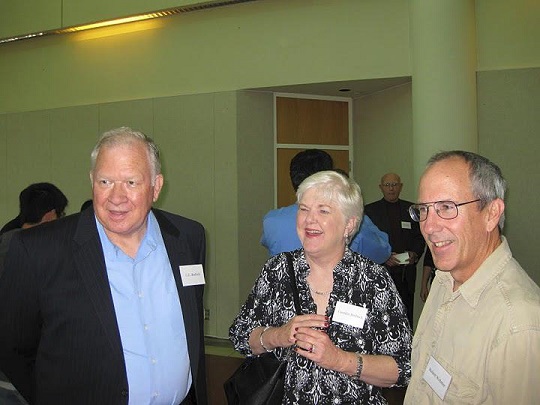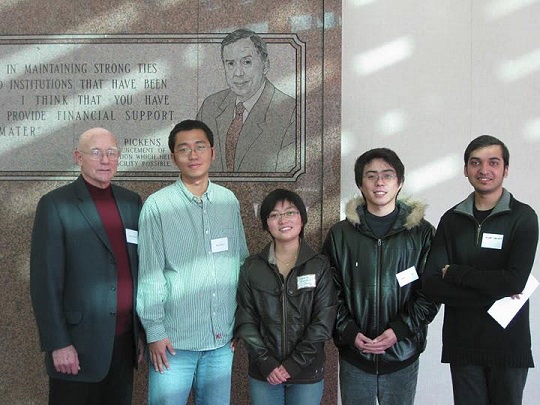OSU Computer Science 40th Anniversary Celebration
By John Chandler
In August of 2008, Prof. M. Samadzadeh pointed out that 2009 would be the fortieth anniversary of the founding of the Computer Science Department, or the Department of Computing and Information Sciences as it was called in 1969. Dr. Samadzadeh suggested it might be appropriate to invite back Dr. Donald D. Fisher, the founder and first head of the department, and to name rooms in the MSCS Building for Dr. Fisher and also for Dr. G. E. "Woody" Hedrick, who was to retire in July of 2009 and who had served a total of 21 years as department head.
Dr. Fisher agreed to come back for the celebration. After months of informal planning and discussion, serious planning got started in early fall of 2009 under the direction of a committee consisting of Dr. Samadzadeh, Dr. Xiaolin Li, Dr. Johnson Thomas, and Dr. John Chandler. Dr. Subhash Kak, head of the department, supported the idea and found funds to pay for a luncheon. The idea of naming the rooms after Dr. Fisher and Dr. Hedrick was supported by the faculty and by Dr. Kak, and by Dr. Peter Sherwood, the Dean of the OSU College of Arts and Sciences, and the naming was eventually approved by the OSU Board of Regents in January of 2010.
Invitations to the luncheon were sent to present and past faculty and staff of the department, to all current Ph.D. students, to alumni for whom we had contact information, and to a few special guests of Dr. Fisher's.
An open house in Dr. Fisher's honor was held on Friday, November 21, 2009. All current faculty, staff, and students of the department were invited, as well as several current and retired faculty from several departments, who had known Dr. Fisher. Those faculty who could attend included Dr. Joe Mize from Industrial Engineering; Dennis Knox from the OSU College of Business, who had been an adjunct member of this department; Dr. Bill Warde from the Department of Statistics; H. E. Bible from the Departments of Mathematics and Statistics; Dr. Carl Latino from the Department of Electrical and Computer Engineering; and Dan Wells, retired professor of Russian language. Dr. Eugene "Ted" Bailey, a former member of the Computer Science faculty, was present at both the open house and the luncheon.
The luncheon was held on Saturday, November 22, 2009, in the atrium of the Noble Research Center. The meal was catered by the Meditations Catering Service. A total of 95 persons attended.
After lunch, John Chandler served as the Master of Ceremonies. Dr. Subhash Kak presented a few remarks on the current state of the department and introduced Dr. Peter Sherwood, Dean of the OSU College of Arts and Sciences, who contributed a few remarks, including some interesting recollections about the state of computing at his alma mater, the University of Cambridge, when he was a student.
Dr. Hedrick thanked the department for honoring him.
As requested, Dr. Fisher reminisced briefly about his hiring in 1969 and the early days of the department.
Dr. Fisher presented awards for 2009 for the Donald and Shirley Fisher Scholarships to Ph.D. student Han Zhao and M.S. student Krishna Lingashetty. Photographs were taken that included the 2008 awardees, Ph.D. student Huanyu Zhao and M.S. student Xiaodan Fang.
The luncheon attendees seemed to enjoy the occasion, and many of them spoke favorably of the luncheon and even of the remarks that followed it.
40 YEARS OF OSU CS - A REFLECTION
A trip down memory lane
By Don Fisher
Vice President for Academic Affairs at Oklahoma State University, Dr. James Boggs, secured approval to establish a Department of Computing and Information Sciences (CIS) starting in the 1969 academic year. In the spring of 1969 he contacted me by telephone to ask if I was interested in helping to establish such a department. At the time, I was Director of the Medical Research Computing Center at Indiana University Medical Center. Dr. Boggs had obtained my name from G.E. Forsythe, Head of the Computer Science (CS) Department at Stanford University. Dr. Forsythe was on my dissertation committee and had hired me to return to the Stanford Computer Center from IBM. I worked with a number of MDs at the Stanford Medical Center, one of whom was on sabbatical leave at Stanford from IU Medical Center. Subsequently I moved to IUMC to head up the Medical Research Computer Center.
When the call from Dr. Boggs came, my wife and I said “Where is Oklahoma?” We had a general idea but had never really been in the south central part of the country. On the interview trip, I was introduced to OSU, Stillwater and Oklahoma and subsequently accepted the offer as Professor and Head of the CIS department. I preferred to refer to the department name as Computing and Information Sciences because the faculty and students would be concerned with computing and information, not the design or modification of computers. On the other hand, “computer science” is the accepted designation for departments because it is shorter and easier to say. I use both CIS and CS below.
1969/70 was a difficult time to recruit faculty to come to OSU to establish a Master’s degree program in CIS. There were few PhD programs in CS at the time and many universities were also establishing CIS departments, most with an emphasis on PhD programs. Even though the competition for faculty was keen, telephone calls to various contacts proved fruitfull. In 1970, three new faculty members were recuited: Dr. D.W. Grace whom I met as grad student at Stanford and who was employed by Procter and Gambel in Cincinnati; Dr. G.E. Hedrick who was recommended by the CS Department Head at Iowa State; Dr. J.P. Chandler who was recommended by the Computer Center Director at Indiana University. This group joined the department in 1970 and served on the faculty for many years. In 1971 another Iowa State grad, Dr. J. R. Van Doren, joined the faculty.
Already involved in teaching CS related courses in 1968/69 were Dr. R. Gumm, Computer Center Director, Dr. T.E. Bailey with degrees in Chemistry, R. Saunders, a graduate student, and Professor D. Knox in the School of Business. The courses consisted primarily of language courses, a numerical methods course and a logic course.
The CIS Department was under Dr. Boggs, which led various deans to inquire why Fisher reported directly to the VP for Academic Affairs. It was good while it lasted, but it became necessary to decide on which College to join. The two choices were Arts and Sciences or Engineering (a College of Sciences would have been the first choice). Since the CIS faculty did not have an engineering background, A&S was the default choice so the CIS Department became one of more than 20 departments in the College of Arts and Sciences. At one point, the Dean of Arts and Sciences decided to coalesce departments into schools, so math, stat and CIS were placed into a School of Mathematical Sciences and I was named Director. That lasted for a few years and then the college returned to departmental structure.
In addition to teaching new classes for the first time, faculty members had to develop new courses, which included course descriptions and course reviews and approval by the curriculum committees, both A&S and University. In order to have an MS program that produced graduates that could be competitive nationally, new upper division courses had to be developed that fed the graduate level courses. Although books were available for some courses, other courses had no supporting textbooks and so the instructor had to develop materials from journal articles or other sources. The computing facility at OSU consisted of an IBM mainframe sequestered behind a wall with a submission window where card decks were handed to a person who placed the decks into an “appropriate” priority queue. Results from a run were printed and appeared sometime later in an alphabetically tagged box. When a program was due, long lines and long delays occurred. The computer was used for both instruction and university business computing. Early on there was a room full of keypunch operators that produced card decks for both academic and business customers. At a later date a card reader and a printer were placed for access by all, which did away with the submission window, but lines still occurred when major class programs were due. Run priority was assigned by job number rather than by a deck being physically put into a certain queue or as some complained, a bottomless stack.
The first MS graduate was Colonel William Misencik on leave from the US Air Force. The first PhD graduate was Brendan Machado who attended the 2009 festivities.
One of the side activities that was undertaken was participation in an attempt to coordinate course activities across math and science classes so that certain classes in one discipline would cover topics in an area used by another discipline in proper order. For example, if a topic in calculus were needed in a physics subject then that topic would precede the topic in physics. This was the brainstorm of an engineering professor who received a grant to investigate such an approach. A room was set aside to hold a giant precedence chart that indicated which topics in math or stat or computing were prerequisite to a given topic in physics or chemistry. The idea was to develop individually paced instruction courses that students could follow to get credit for a course. I was familiar with two courses that had some success: Fortran programming and astronomy. Neither was a long term success because of the time required to make up multiple assessments for each unit within a course.
One of the side activities that was undertaken was participation in an attempt to coordinate course activities across math and science classes so that certain classes in one discipline would cover topics in an area used by another discipline in proper order. For example, if a topic in calculus were needed in a physics subject then that topic would precede the topic in physics. This was the brainstorm of an engineering professor who received a grant to investigate such an approach. A room was set aside to hold a giant precedence chart that indicated which topics in math or stat or computing were prerequisite to a given topic in physics or chemistry. The idea was to develop individually paced instruction courses that students could follow to get credit for a course. I was familiar with two courses that had some success: Fortran programming and astronomy. Neither was a long term success because of the time required to make up multiple assessments for each unit within a course.
I admit to being biased, but I do feel that the MS degree program in CIS was/is a strong program as evidenced by the many graduates who have assumed high level positions in the computing field. I will let those familiar with the PhD program judge it. --- Don Fisher
Dr. Don Fisher is still helping students today with the Fisher Scholarship.



